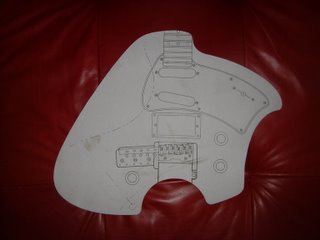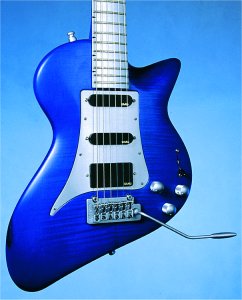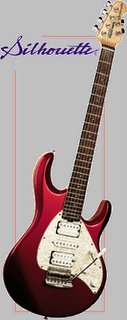Should I use a pickguard?
Due to my lack of woodworking experience and my desire to build an electric guitar sooner rather than later, some of my decisions will be dictated by ease of construction. I was fortunate with the MDF guitar template. It was my first attempt at using hand tools for shaping and it came out quite well as seen here.
 I don’t want to count on this level of success going forward (beginner’s luck?) so I’m now considering the use of a pickguard or scratch plate.
I don’t want to count on this level of success going forward (beginner’s luck?) so I’m now considering the use of a pickguard or scratch plate.
A pickguard simplifies things quite a bit. First, it simplifies routing. Rather than use a rear routed layout, which requires both front and rear routing, a pickguard only requires front routing. A good choice would be a universal route also referred to as a “bathtub route”. This would make it easy to switch to different pickups at a later point. Second, it simplifies fit and finish because the route is hidden by the pickguard. I don’t have to worry about the routing being terribly precise. Third, a pickguard typically screws onto the face of the guitar which eliminates the concern of recessing a control cover for a rear cavity.
The Klein uses a pickguard but its not the solution I’m looking for. The original pickguard only deals with the neck and middle pickups. As a result, its still a combination of both rear and front routing. That defeats my purpose so I have to explore a new pickguard design.
I’ve been looking at different designs and so far these two hold promise:

I really like the flowing lines of the pickguard on this Andreas Shark and the fact that it does not wrap around either the bridge or the neck.

Meanwhile, the Musicman Silhouette Electric Guitar simply and elegantly covers my requirement of incorporating pickups, switch and knobs into the pickguard. The likelihood is that I will combine elements from each to arrive at my pickguard.
A pickguard also contributes to the aesthetics of the guitar but that is another matter…
The pickguard on that Andreas Shark looks useless.
@Jordan – You don’t really elaborate on why its “useless” but if you’re talking about it as a strict pickguard, I agree. But then again, I’ve never really seen much reason for pickguards as pick guards. 🙂
As far as guitar building – the point of the article – it offers some flexibility in approach and layout. It also makes it possible to make easy changes to pick up layouts.
As far as my first build, I opted to do without after experimenting with several formats.
Pickguard design is actually quite hard. A good idea is to look at your old guitars to see where most of your wear occurs and design it around those areas. I think the Shark guard is really good looking and I agree with your logic that fully covering the pickups allows you flexibility in future by using generic routes.